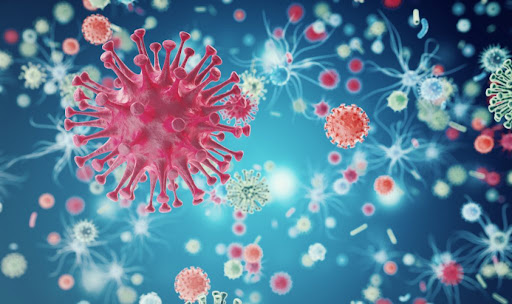Since the beginning of the COVID-19 pandemic, the word ‘virus’ has become a household term, being used in casual conversation on a day-to-day basis in every corner of the world. But what exactly is a virus? How does it differ from other infectious agents? And are all viruses equal?
Table of contents for this article
What is a virus?
Viruses are small groups of genetic code, such as DNA or RNA, enclosed within a shell of protein. A virus cannot survive or multiply on its own, nor can it obtain or store energy. It requires a living organism, or host, which it must inhabit to perform these functions that are basic to life. Hosts can be bacteria, plants, or animals,including human beings.
The incapability of a virus to survive without a host means that they are classed as non-living entities.
Some viruses, like the coronavirus SARS-CoV-2 behind COVID-19, infect the host for a number of days or weeks before being cleared from the system. Other viruses, like varicella-zoster that causes chickenpox, and the human immunodeficiency virus (HIV), can sit dormant in a host without causing an active infection for a number of years.

Read here to find out what happens when you’ve had a Covid test, from collection to results
How does a virus spread?
Most people are now aware that the SARS-CoV-2 virus can be spread through respiratory infection symptoms such as sneezing and coughing, and can also be spread through actions such as speaking or breathing.
There are four primary forms of transmission in which viruses spread:
1. Airborne transmission: Airborne transmission occurs when infected viral droplets in the air are inhaled by another living organism. Airborne transmission is how COVID-19 is commonly spread.
2. Vehicle transmission: Vehicle transmission occurs when food, water, body fluids, or inanimate objects passively carry the virus and transmit it when they come in contact with a potential host organism.
3. Direct transmission: Direct contact transmission occurs when viral particles are spread through physical contact between an infected and uninfected animal, plant, or human being. Examples include ingesting infected foodstuffs or transmission via kissing or sexual activity.
4. Indirect transmission: Indirect contact transmission occurs when the viral particles are spread via contact with contaminated materials such as unsterile medical equipment.
Difference between Viruses and bacteria
On the surface of it, viruses and bacteria may seem very similar. They are spread from human to human in very similar ways and can have similar ravaging effects on human bodies. However, there are in fact far more differences than similarities between them.
Viruses are much smaller than bacteria, and even the largest virus is tinier than the smallest bacterium.
A virus needs a living host to survive, thrive and multiply. This is not the case for bacteria, and they can live independently in almost any environment.
Treatment for bacterial infection is primarily via antibiotics. Antibiotics do not have an effect on viruses, which are generally treated with anti-viral agents where available.
Vaccines are an important preventive agent against viruses.
Common viral infections
- Coronavirus
- Influenza – causes ‘the ‘flu’
- Rhinoviruses – cause the ‘common cold’
- Human papillomavirus (HPV) – causes genital warts and cervical cancer
- Varicella-zoster – causes chickenpox
- Noroviruses – cause vomiting and diarrhoea
- Measles
- Mumps
What is the endgame of a virus?
From an evolutionary perspective, the ‘perfect’ virus is one that infects as many hosts as possible to replicate, without killing the host in the process, because the host is needed to aid transmission. The SARS-CoV-2 virus does this very well. Most infected people don’t die from the infection, and it has a relatively long incubation period, which is the time from infection to the point where symptoms are first displayed. This, and the highly effective manner in which it is transmitted through the air, make it a very successful virus.

